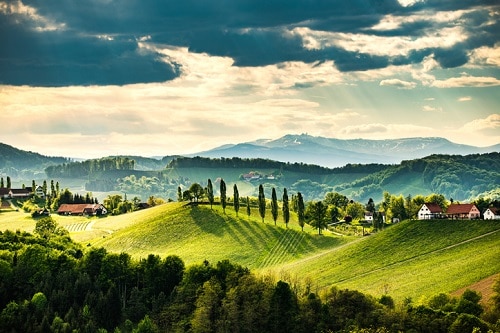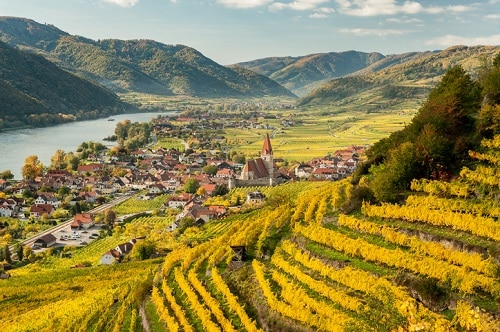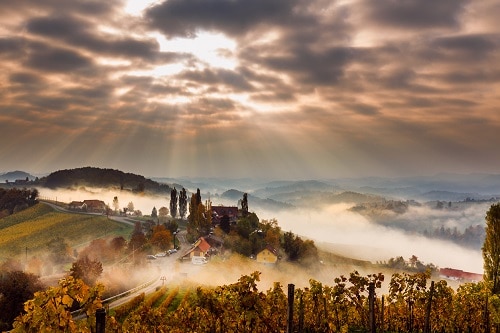Grüner Veltliner Grape Variety & Wine Profile
(Pronounced “grooh-ner VELT-leehn-er”)
Grüner Veltliner is Austria’s grape gang leader whose turf continues to expand, causing some serious upsets. AKA Grüner, GruVe (kind of like “groovy”), or GV, depending on who’s asking, has no problem with getting in your face and letting you know who you’re fooling with. Kidding aside, Grüner Veltliner is named for its color and hometown. The word Grüner means green in English, and Veltliner is its village of origin. Genetic analysis shows that it’s the offspring of Savagnin and an obscure Austrian grapevine named St. Georgener-Rebe that produces no grapes.
Today Grüner Veltliner is prized as Austria’s “Very Own” and most widely planted grape. While it dates back to the mid-1800s, its resident adoration didn’t start until the mid-1900s when it became the favorite wine served in wine-gardens, known as Heurigen’s and Buschenschank’s. Here vineyard keepers serve fresh glasses of the current vintage in a warm and cozy atmosphere. For #Winetravelers, then and now, Heurigen’s and Buschenschank’s are places to socialize, relax, and, most importantly, sample authentic Austrian wine and food.
Later in the early 2000s, Grüner Veltliner went from being a local wine bottled in liter format with a crown cap to gaining international attention as a contender rivaling Chardonnay. How? Because of Grüner Veltliner’s supernatural ability to match with virtually any food, including the bitterly uncooperative artichoke and asparagus. Grüner’s friendly disposition landed it in a prestigious blind-tasting conducted by world-renowned wine experts. Pitted against Chardonnay, “GruVe” swept 7 out of 10 categories proving its ability to produce fine, full-bodied wines capable of aging.
Terroir and Grüner Veltliner Growing Regions
To express its full potential, GV needs to be planted on mineral-rich slopes composed of silt, sand, clay, and rock with sunny exposure and cool evening breezes. While Austria’s finest expressions come from vineyards above the Danube River, in Wachau, Kremstal, and Kamptal regions, it’s also cultivated in neighboring Trentino-Alto Adige Valle Isarco, Italy, the Czech Republic, Slovakia, and Hungary. But since quality Grüner Veltliner has begun to make a global impact, vines have been planted in Portugal, Adelaide Hills, Australia, Central Otago, New Zealand, Clarksburg, San Benito, Santa Barbara, Santa Cruz, Willamette Valley, Edna Valley, Umpqua Valley, Columbia Gorge and Washington.
Grüner Veltliner Tasting Notes
Grüner Veltliner is typically vinified as a single variety, and it is made into an incredible spectrum of styles and structures, from long-aging, richly dense, fruited wines to high-toned, electric, racy, sparkling, sweet and eiswein. Its color is pale straw with hints of green and can have a slight effervescence in youth, giving rise to vivid aromatics of grapefruit, lime, lemon, white flowers, gunpowder, dill, and wasabi. In terms of taste, expect searing acidity followed by yellow apple, tropical fruit, radish, arugula, watercress, tarragon, sage, ginger, honey, and saffron.
Food Pairing Grüner Veltliner Wines
As mentioned, GV has the capacity to complement practically any food. Still, there are some extraordinary standouts, starting with Austrian wiener schnitzel, American fried chicken, vegan fare, sushi, curries, spicy Thai and Vietnamese, summer rolls, noodle salad, dim sum, barbeque ribs, fresh cheeses, zucchini and the notorious wine killers like salads with vinaigrette dressing, cabbage, sprouts, kale, pickles and the already mentioned asparagus and artichoke.
Countries Producing Grüner Veltliner
Austria
Italy
Czech Republic
Slovakia
Hungary
Portugal
New Zealand
Australia
USA
Major Grüner Veltliner Producers by Country
Austria
Hirtzberger, Smaragd, Wachau
Emmerich Knoll Loibner Schutt, Wachau
F.X. Pichler Loibner Klostersatz, Wachau
Prager Smaragd, Wachau
Nikolaihof, Wachau
Salomon Undhof, Kremstal
Nigl, Kremstal
Willi Brundlmayer, Kamptal
Schloss Gobelsburg, Kamptal
Ewald Gruber-Roschitz, Niederosterreich
Italy
Tenuta Spitalerhof, Trentino-Alto Adige
Kellerei Cantina Valle Isarco, Sudtirol Eisacktaler Trentino-Alto Adige
Manni Nossing Sudtirol Eisacktaler, Trentino-Alto Adige
Abbazia di Novacella-Kloster, Sudtirol Eisacktaler, Trentino-Alto Adige
Czech Republic
Vino Z, Moravia
Edelspitz, Moravia
Arte Vini, Moravia
Slovakia
Naboso Dumas Welsch, Bratislava
Hungary
Count Karolyi
Floriana
Tuzko Birtok, Szekszard
Portugal
Broadbent
New Zealand
Jules Taylor, Marlborough
Coopers Creek, Gisborne
Yealands Estate, Awatere Valley
Mount Edward Morrison, Central Otago
Australia
Nepenthe Winemaker’s Selection, Adelaide Hills
Hahndorf Hill Winery, Adelaide Hills
Stoney Rise, Tamar Valley
Lark Hill, Canberra District
USA
Dr. Konstantin Frank, Finger Lakes
Zugibe, Finger Lakes
Black Star Farms, Old Mission Peninsula
Savage Grace, Columbia Gorge
Scenic Valley Farms, Willamette Valley
Illahe Estate Willamette Valley
Belden Barns Estate, Sonoma Mountain
Dancing Coyote, Clarksburg
Vocal Vineyards, Santa Cruz Mountains
Williams Selyem, San Benito
Baker & Brain Paragon, Edna Valley
Lincourt, Sta Rita Hills
Tatomer, Santa Barbara County
Learn About These Other Wine Grape Varieties
Written By Jeff Bareilles
Jeff or “JB” is a native to the San Francisco Bay area and wants to live in a world where wine is served with every meal. As a beverage and food professional with more than 20 years of experience, he’s contributed to The Food Lover’s Guide to Wine; The Pho Cookbook (James Beard Award Best Signal Subject 2018); Unforgettable: The Bold Flavors of Paula Wolfert’s Renegade Life (James Beard Award Lifetime Achievement Award 2018); Manresa: An Edible Reflection; Happiness is on the Plate: Episode #1; Wine Spectator; Wine Enthusiast; The Wall Street Journal; San Francisco Chronicle; and GQ Magazine. When he’s not “tasting” and eating he’s writing about food and beverage or developing recipes in his laboratory (AKA: kitchen).
The Structure and Style of Grüner Veltliner Wines
Body Medium Minus
Sugar Dry
Acid Medium Plus
Alcohol Medium Minus
Tannins Light



